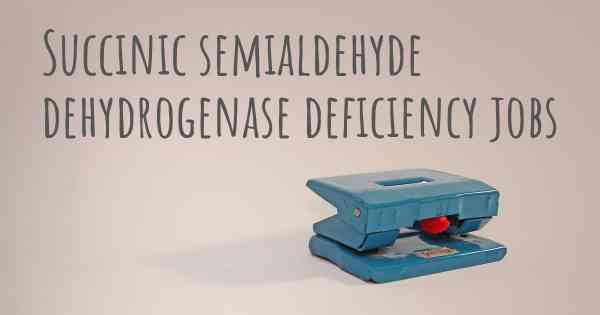Can people with Succinic semialdehyde dehydrogenase deficiency work? What kind of work can they perform?
See how people with experience in Succinic semialdehyde dehydrogenase deficiency give their opinion about whether people with Succinic semialdehyde dehydrogenase deficiency can work and what kind of jobs are more appropriated for people with Succinic semialdehyde dehydrogenase deficiency

Can people with Succinic semialdehyde dehydrogenase deficiency work?
Succinic semialdehyde dehydrogenase deficiency (SSADH deficiency) is a rare genetic disorder that affects the metabolism of the neurotransmitter gamma-aminobutyric acid (GABA). Individuals with SSADH deficiency have a mutation in the ALDH5A1 gene, which leads to a deficiency in the enzyme succinic semialdehyde dehydrogenase. This enzyme is responsible for breaking down succinic semialdehyde, a byproduct of GABA metabolism, into succinic acid.
SSADH deficiency can result in a range of symptoms, including developmental delays, intellectual disability, seizures, hypotonia (low muscle tone), ataxia (lack of muscle coordination), and behavioral problems. The severity of symptoms can vary widely among individuals, with some experiencing mild impairments while others may have more significant challenges.
Given the potential impact of SSADH deficiency on cognitive and physical abilities, it is important to consider the individual's specific capabilities and limitations when determining their ability to work. While SSADH deficiency may present challenges, it does not necessarily preclude individuals from engaging in meaningful employment.
Factors influencing work capabilities:
1. Severity of symptoms: The severity of SSADH deficiency symptoms can vary greatly among individuals. Some individuals may have mild impairments that do not significantly impact their ability to work, while others may have more significant challenges that require additional support.
2. Cognitive abilities: SSADH deficiency can affect cognitive function, including intellectual abilities and learning difficulties. Depending on the individual's cognitive capabilities, they may be able to perform certain types of work that align with their strengths and abilities.
3. Physical limitations: Ataxia and hypotonia, common symptoms of SSADH deficiency, can affect muscle coordination and strength. This may limit the individual's ability to perform physically demanding tasks or jobs that require fine motor skills. However, there are many types of work that do not rely heavily on physical abilities.
4. Behavioral challenges: Some individuals with SSADH deficiency may experience behavioral problems, such as impulsivity, hyperactivity, or difficulties with social interactions. These challenges may impact their ability to work in certain environments or require accommodations to ensure their success in the workplace.
Potential work options:
1. Office-based work: Individuals with SSADH deficiency who have good cognitive abilities but may have physical limitations can consider office-based work. This can include administrative tasks, data entry, customer service, or other roles that primarily involve working with computers and minimal physical demands.
2. Artistic and creative pursuits: Some individuals with SSADH deficiency may have strengths in artistic or creative areas. They can explore careers in art, music, writing, or other creative fields that allow them to express their talents and abilities.
3. Remote or flexible work: For individuals who may face challenges in traditional work environments, remote or flexible work options can provide greater flexibility and accommodations. This can include freelance work, telecommuting, or self-employment.
4. Supportive work environments: It is important for individuals with SSADH deficiency to work in environments that understand and accommodate their specific needs. Supportive employers and workplaces that prioritize inclusivity and provide necessary accommodations can greatly enhance the individual's work experience.
Conclusion:
While Succinic semialdehyde dehydrogenase deficiency (SSADH deficiency) can present challenges, individuals with this condition can still pursue meaningful employment. The severity of symptoms, cognitive abilities, physical limitations, and behavioral challenges should be taken into consideration when determining suitable work options. Office-based work, artistic pursuits, remote or flexible work, and supportive work environments are potential avenues for individuals with SSADH deficiency to explore. It is important to provide appropriate accommodations and support to ensure their success in the workplace.








